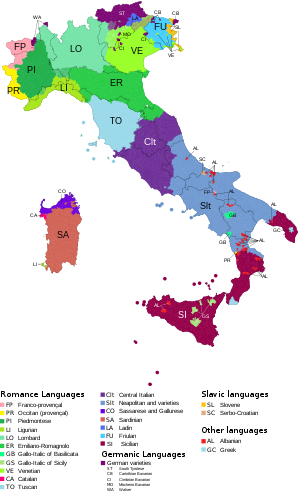| Part of a series on the |
| Culture of Italy |
|---|
 |
| People |
| Traditions |
| This article is part of the series on the |
| Italian language |
|---|
| History |
| Literature and other |
| Grammar |
| Alphabet |
| Phonology |
The languages of Italy include Italian, which serves as the country's national language, in its standard and regional forms, as well as numerous local and regional languages, most of which, like Italian, belong to the broader Romance group. The majority of languages often labeled as regional are distributed in a continuum across the regions' administrative boundaries, with speakers from one locale within a single region being typically aware of the features distinguishing their own variety from others spoken nearby.[6]
The official and most widely spoken language across the country is Italian, which started off based on the medieval Tuscan of Florence. In parallel, many Italians also communicate in one of the local languages, most of which, like Tuscan, are indigenous evolutions of Vulgar Latin. Some local languages do not stem from Latin, however, but belong to other Indo-European branches, such as Cimbrian (Germanic), Arbëresh (Albanian), Slavomolisano (Slavic) and Griko (Greek). Other non-indigenous languages are spoken by a substantial percentage of the population due to immigration.
Of the indigenous languages, twelve are officially recognized as spoken by linguistic minorities:[7] Albanian,[8][9] Catalan, German, Greek, Slovene, Croatian, French, Franco-Provençal, Friulian, Ladin, Occitan and Sardinian;[7] at the present moment, Sardinian is regarded as the largest of such groups, with approximately one million speakers, even though the Sardophone community is overall declining.[10][11][12][13][14][15] However, full bilingualism (bilinguismo perfetto) is legally granted only to the three national minorities whose mother tongue is German, Slovene or French, and enacted in the regions of Trentino-Alto Adige, Friuli-Venezia Giulia and the Aosta Valley, respectively.
- ^ Tagliavini, Carlo (1962). Le origini delle lingue neolatine: introduzione alla filologia romanza. R. Patròn. Archived from the original on 26 February 2018. Retrieved 8 January 2008.
- ^ "La variazione diatopica". Archived from the original on 16 February 2012.
- ^ [1] Archived 7 November 2005 at the Wayback Machine
- ^ AIS, Sprach-und Sachatlas Italiens und der Südschweiz, Zofingen 1928-1940
- ^ "Cittadini Stranieri in Italia - 2018".
- ^ "Italy". Ethnologue. Retrieved 22 July 2017.
- ^ a b Norme in materia di tutela delle minoranze linguistiche storiche, Italian parliament, retrieved 17 October 2015: "1. In attuazione dell'articolo 6 della Costituzione e in armonia con i princípi generali stabiliti dagli organismi europei e internazionali, la Repubblica tutela la lingua e la cultura delle popolazioni albanesi, catalane, germaniche, greche, slovene e croate e di quelle parlanti il francese, il franco-provenzale, il friulano, il ladino, l'occitano e il sardo."
- ^ Curtis, Matthew C. (2018). "99. The dialectology of Albanian". In Fritz, Matthias; Joseph, Brian; Klein, Jared (eds.). Handbook of Comparative and Historical Indo-European Linguistics. de Gruyter Mouton. p. 1800. ISBN 9783110542431.
The Albanian language is spoken natively by approximately 6 million speakers in south- eastern Europe, particularly in Albania and Kosovo where it is an offlcial language, but also in Macedonia, Serbia, Montenegro, and Italy where it has the status of a minority language.
- ^ "Albanians in Italy". Minority Rights Group International.
- ^ "Letture e linguaggio. Indagine Multiscopo sulle famiglie "I cittadini e il tempo libero"" (PDF). ISTAT. 2000. pp. 106–107.
- ^ «With some 1,6 million speakers, Sardinia is the largest minority language in Italy. Sardinians form an ethnic minority since they show a strong awareness of being an indigenous group with a language and a culture of their own. Although Sardinian appears to be recessive in use, it is still spoken and understood by a majority of the population on the island.» Kurt Braunmüller, Gisella Ferraresi (2003). Aspects of multilingualism in European language history. Amsterdam/Philadelphia: University of Hamburg: John Benjamins Publishing Company. p. 238.
- ^ «Nel 1948 la Sardegna diventa, anche per le sue peculiarità linguistiche, Regione Autonoma a statuto speciale. Tuttavia a livello politico, ufficiale, non cambia molto per la minoranza linguistica sarda, che, con circa 1,2 milioni di parlanti, è la più numerosa tra tutte le comunità alloglotte esistenti sul territorio italiano.» Wolftraud De Concini (2003). Gli altri d'Italia : minoranze linguistiche allo specchio. Pergine Valsugana: Comune. p. 196.
- ^ «Sebbene in continua diminuzione, i sardi costituiscono tuttora la più grossa minoranza linguistica dello stato italiano con ca. 1.000.000 di parlanti stimati (erano 1.269.000 secondo le stime basate sul censimento del 2001)». Sergio Lubello (2016). Manuale Di Linguistica Italiana. Manuals of Romance linguistics. De Gruyter. p. 499.
- ^ "Lingue di Minoranza e Scuola, Sardo". Archived from the original on 16 October 2018. Retrieved 12 January 2019.
- ^ "What Languages are Spoken in Italy?". 29 July 2019.

